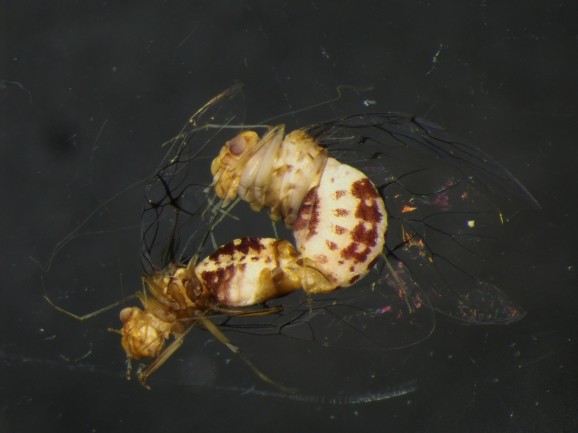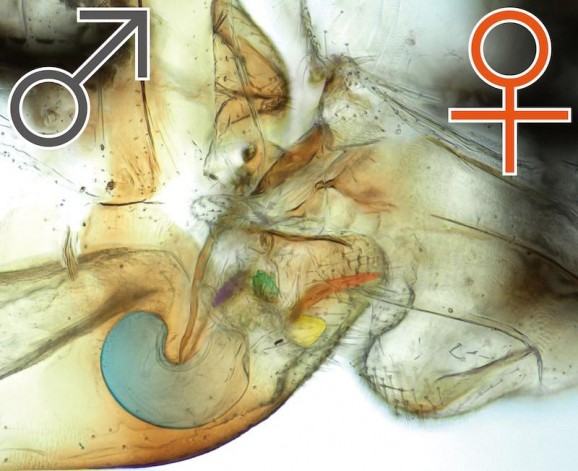Move Over, Praying Mantis, This Bug Sex Is Weirder Than Yours
This article is more than 2 years old
 The only thing I know about insect sex is that the praying mantis female often eats the male after they mate, sometimes even during the act. However, the male has a brain at the tail end of his body that allows him to finish undeterred. Good times. The praying mantis is far from the only insect with rather unorthodox mating rituals. Recently, scientists discovered that Neotrogla, a lice-like insect that lives in the caves of southeast Brazil, has an interesting arrangement of sexual organs, namely, the female insect is the one with the penis.
The only thing I know about insect sex is that the praying mantis female often eats the male after they mate, sometimes even during the act. However, the male has a brain at the tail end of his body that allows him to finish undeterred. Good times. The praying mantis is far from the only insect with rather unorthodox mating rituals. Recently, scientists discovered that Neotrogla, a lice-like insect that lives in the caves of southeast Brazil, has an interesting arrangement of sexual organs, namely, the female insect is the one with the penis.
Roger Ferreira, a Brazilian biologist published his findings in Current Biology, spent a good amount of time peeping on these insects as they mated. That would be one of the weirder aspects of the job, wouldn’t it? “What did you do today, honey?” “Oh, you know, I watched a bunch of insects do it. And I took photos.” But hey, how else would we know about this bizarre stuff? Ferreira snapped pictures but didn’t video record the insects—he didn’t want to disturb them. How considerate. He and his team kept their observations to 30-minute sessions, which turned out to be plenty of time.
 The female Neotrogla mounts the male, which is already a departure from the usual MO of animal sex. She then penetrates him with a gynosome, which is very similar to a penis, especially because the membrane that composes it hardens before she does this. The cringe-inducing part is next: this gynosome is so long that it pierces the male’s abdomen. That’s not all. It has hooks at the end that attach to pouches inside the male’s body, so the two are quite literally fastened together. The male then transfers his sperm to a duct inside his body, and she finishes the job by harvesting it into her own body. Scientists think that the pouches inside the male’s abdomens developed over time as a way to reduce the pain of the process. Come on, evolution, how about figuring out a different way to do this?
The female Neotrogla mounts the male, which is already a departure from the usual MO of animal sex. She then penetrates him with a gynosome, which is very similar to a penis, especially because the membrane that composes it hardens before she does this. The cringe-inducing part is next: this gynosome is so long that it pierces the male’s abdomen. That’s not all. It has hooks at the end that attach to pouches inside the male’s body, so the two are quite literally fastened together. The male then transfers his sperm to a duct inside his body, and she finishes the job by harvesting it into her own body. Scientists think that the pouches inside the male’s abdomens developed over time as a way to reduce the pain of the process. Come on, evolution, how about figuring out a different way to do this?
The scientists wanted to test how strong the copulative hold is, so they, um…well, they pulled mating insects apart. That’s just mean. I’ll give you one guess as to what happened. Yes, the male insect basically comes apart and still the hold doesn’t break. That may be because females compete to do this. I hear the competition isn’t quite so stiff among the males. And, in case that wasn’t bad enough, the insects engage in marathon sex—somewhere between 40-70 hours.
The process of transmitting sperm doesn’t take all that long, but some scientists think that, like the partner-eating mantis, the female insects gains nutrients from the males that are necessary to producing all of those eggs. Other scientists think the duration is at the male’s behest, to guard the female against mating with anyone else. Ferreira and his team will continue monitoring the mating behavior, and will extend their studies to other related insects.
I have to say, if I were the male, I might opt to have my head eaten off.












